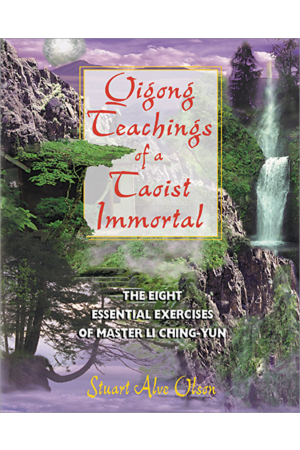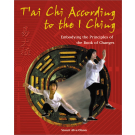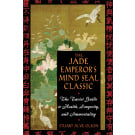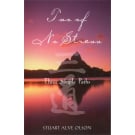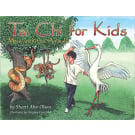Qigong Teachings of a Taoist Immortal
The Eight Essential Exercises of Master Li Ching-yun
- Pages: 192
- Book Size: 8 x 10
- ISBN-13: 9780892819454
- Imprint: Healing Arts Press
- On Sale Date: January 1, 2002
- Format: Paperback Book
- Illustrations: 85 b&w illustrations
• Explains the physical and spiritual benefits of the Eight Brocades and offers step-by-step instructions for this powerful sequence of postures.
• 85 illustrations highlight the postures and philosophies.
• Author's commentary provides insight and depth to the original translation.
Throughout history Taoists have promoted the development and restoration of the Three Treasures-- body, breath, and spirit--through the gentle practice of qigong. At the center of the qigong practice are the Eight Brocades, a series of postures that developed during the 3,000-year Taoist quest for longevity and vitality. Now qigong expert Stuart Olson translates into English Master Li Ching-yun's treasured teachings on the Eight Brocades. One of the most famous qigong masters of this century, Master Li Ching-yun is reliably chronicled to have lived more than 250 years, during which he practiced the Eight Brocades on a daily basis. His longevity and personal endorsements attest to and validate the Eight Brocades as the quintessence of Taoist health and qigong practices.
With Master Li Ching-yun's original teachings as a guide, Stuart Olson presents an authentic yet accessible approach to this unique practice. Each exercise is accompanied by original text from Master Li, step-by-step instructions for each posture, illustrations of the positions, and insights on theory and practice. Because the Eight Brocades are the foundation of all qigong, this book provides valuable advice for all practitioners, regardless of the style they practice or the depth of their experience.
THE SECOND BROCADE
Shake the Heavenly Pillar
This chapter, like the preceding, begins with my translation of the instructions, commentary, and correct method that were included in the Kao Lin engraving. Following the original text are Li Ching-yun's commentary and my comments, and finally my instructions for practicing the Second Brocade.
The Original Text
Gently shake the Heavenly Pillar.
Sway the head left and right while gazing at the shoulders. Do so alternately in conjunction with the movements, twenty-four times. It is necessary to first grasp the hands firmly.
The correct method: First, grasp the hands firmly. Alternately turn the head left and right, gazing toward the shoulders when following the movements of the head, twenty-four times.
Li Ching-yun's Commentary
Author's Comments
Note the position of the hands and head in the drawing. The hands are not closed into fists, rather the right hand is placed on top of the left palm, and the head is tilted upward and away from the left shoulder. This is another example of the variant meanings of "grasp the hands firmly."
In this brocade, the hands should be held in the t'ai chi knot. When gazing toward the left side, the right hand grasps the left thumb and the left hand covers the back of the right hand. When gazing to the right side, the positioning is exactly the opposite (see the photographs).
For further information, refer to the book Tibetan Yoga and Secret Doctrines by W. Y. Evans-Wentz. In the section on producing psychic heat, the Nine Bellowslike Breathing exercise is very similar to this exercise of Shake the Heavenly Pillar.
[Li ching-yun's voice] The Heavenly Pillar is the spinal column and the connective neck bone. To gently shake (to wave to and fro) means to sway the shoulders. Gently shake the Heavenly Pillar means to crick and move the neck. Properly, the neck is cricked to the left and right sides along with a gazing procedure. The two shoulders are followed by the gaze when swaying. The left and right sides are counted separately, with each side being performed twenty-four times, and collectively forty-eight times.
This cricking of the neck, swaying of the shoulders, and gazing in accordance with the movements in effect remove the fire of the heart and eliminate any invasions or disturbances of external malignant spirits.
Author's Comments
The Heavenly Pillar is a Taoist metaphor for the spinal column and connective neck bone. The first character (representing wei) of this section of the text normally translates as "subtle" or "secretly." Following Li Ching-yun's lead, I consider it best to translate this as "gently."
Note that under the "Concluding Exercises" at the end of part 2, there is also the instruction to shake the shoulders, which, however, is distinct from this exercise. I bring this up because many Eight Brocades texts, in both English and Chinese, do not differentiate between these two methods.
Author's Instructions
Using the t'ai chi knot method, shake the Heavenly Pillar twenty-four times, gazing first to the left twelve times and then to the right twelve times.
With the legs crossed, grasp the hands firmly using the t'ai chi knot (right hand grasping left-hand thumb) and place the bottom edge of the right palm on the right thigh, near the hip, and with the Tiger's Mouth cavity (hu k'o)--the indentation formed at the base of the thumb and index finger--facing upward. Place the tongue against the roof of the mouth.
Begin to gently shake the Heavenly Pillar by turning the right shoulder, spine, and head toward the left. Inhale while turning and direct the eyes to the top of the left shoulder, then continue by gazing up and back as far as possible, stretching and twisting the spine smoothly, gradually, and in conjunction with natural breathing. Simultaneously, the right hand is pressed into the right thigh and the left-hand thumb joint is pressing down on the right-hand Tiger's Mouth cavity. Then exhale and bring the gaze back down to the shoulder and then to the front. Repeat this twelve times.
[PHOTOS FOR 2ND BROCADE HERE--the following are captions and labels for the exercise photos]
Shaking the Heavenly Pillar toward the left
Right hand presses into right thigh
Eyes gaze upward and to the left
Shaking the Heavenly Pillar toward the right
Eyes gaze upward and to the right
Left hand presses into left thigh
Next, perform the exercise from the right, or opposite, side: the left hand grasps the right thumb and presses down on the left thigh, while the thumb joint of the right hand presses into the left-hand Tiger's Mouth and the eyes gaze up and over the right shoulder. Again, perform the movements twelve times.
This brocade is good for strengthening the spine and exercising the eyes, and increasing the blood flow to the waist, legs, and hands.
This brocade stimulates the spleen.
Acknowledgments
Introduction
Part 1
The Development of Qigong
Taoist Longevity Practices and the Three Treasures
Taoist Longevity practices
Arts of Nourishing Life
Abdominal Breathing
The Three Treasures
Ching
Qi
Shen
Part 2
The Eight Brocades--The Physical Practice
The Traditional Method, with Commentaries
Author's Introduction to the Eight Brocades
The Development of the Eight Brocades
Practicing and Finding a Teacher
Li Ching-yun
Li Ching-yun's Introduction to the Original Text of the Eight Brocades
The Methods of the Eight Diagram Active Kung
Secrets of the Eight Brocades
The First Brocade: The Heavenly Drum
The Original Text
Li Ching-yun's Commentary
Author's Instructions
The Second Brocade: Shake the Heavenly Pillar
The Original Text
Li Ching-yun's Commentary
Author's Instructions
The Third Brocade: The Red Dragon Stirs the Sea
The Original Text
Li Ching-yun's Commentary
Author's Instructions
The Fourth Brocade: Rub the Court of the Kidneys
The Original Text
Li Ching-yun's Commentary
Author's Instructions
The Fifth Brocade: The Single Pass Windlass
The Original Text
Li Ching-yun's Commentary
Author's Instructions
The Sixth Brocade: The Double Pass Windlass
The Original Text
Li Ching-yun's Commentary
Author's Instructions
The Seventh Brocade: Supporting Heaven
The Original Text
Li Ching-yun's Commentary
Author's Instructions
The Eighth Brocade: Grasping with Hooks
The Original Text
Li Ching-yun's Commentary
Author's Instructions
Concluding Exercises and Comments
Concluding Exercises: The Original Text
Li Ching-yun's Commentary
Author's Instructions
Concluding Comments
Appendix to Part 2: Summary of Instructions
Part 3
The Lesser Heavenly Circuit--The Spiritual Practice
Three Interrelated Techniques
Author's Introduction to the Lesser Heavenly Circuit
Development of the Lesser Heavenly Circuit
The First Regime: Externally Patting the Eight Subtle Meridians and
Twelve Cavities
The Eight Subtle Meridians
The Twelve Cavities--Methods for Self-Massage
The Second Regime: Internally Opening the Eight Subtle Qi Cavities
The Eight Subtle Qi Cavities
The Third Regime: The Lesser Heavenly Circuit
Appendix to Part 3: Summary of Instructions
Suggested Reading
About the Author
Throughout history Taoists have promoted the development and restoration of the Three Treasures--body, breath, and spirit--through the gentle practice of qigong. At the center of this practice are the Eight Brocades, a series of seated postures that developed during the 3,000-year Taoist quest for longevity and vitality. Now Stuart Olson provides the first English translation of Master Li Ching-yun’s treasured teachings on the Eight Brocades. One of the most famous qigong masters of this century, Master Li Ching-yun is reliably chronicled to have lived more than 250 years, during which he practiced the Eight Brocades on a daily basis. His longevity and personal endorsements attest to and validate the Eight Brocades as the quintessence of Taoist health and qigong practices.
With Master Li Ching-yun’s time-honored teachings as a guide, Stuart Olson presents an authentic yet accessible approach to this unique practice. Each exercise begins with its original Eight Brocades text, which comes from the Kao Lin stone engraving of the old Hangchou period, followed by Master Li’s interpretation of that text and explanatory comments from Olson. Also included are step-by-step instructions for each exercise, fully illustrated with detailed photographs of Olson performing the exercises. Because the Eight Brocades are the foundation of all qigong, this book provides valuable advice for all practitioners, regardless of the style they practice or the depth of their experience.
STUART ALVE OLSON currently teaches Eight Brocade Qigong, Taoist meditation, and I T’ai Chi. He has studied under numerous Taoist masters including Ch’an master Hsuan Hua, Kung fu and healing master Oei Khong-hwei, Dharma master Cheng Yi, and T’ai Chi Ch’uan master T. T. Liang. He is the author of T’ai Chi According to the I Ching, Tai Chi for Kids, and Tao of No Stress. He lives in the S an Francisco Bay Area.



